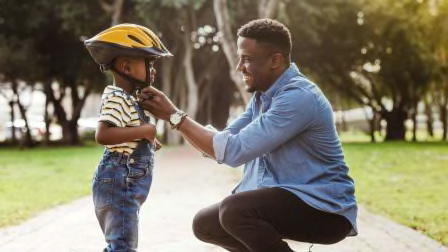Do You Need an E-Bike-Specific Helmet?
For electric bike riders who want more protection, there are bike helmets that meet stricter safety standards. Plus, a few helmet picks from CR's ratings.
When you shop through retailer links on our site, we may earn affiliate commissions. 100% of the fees we collect are used to support our nonprofit mission. Learn more.

In recent years, electric bikes have become more popular than ever. In fact, 11 percent of Americans say they have ridden an electric bike in the past year, according to a February 2024 nationally representative survey (PDF) of 2,035 U.S. adults conducted by Consumer Reports.
Wearing a helmet is important any time you get on any type of bike. Yet many electric bikes can reach speeds that casual riders won’t on a conventional bike. And you can find some helmets that are advertised as being specifically for e-bike riders.
So do you need an e-bike helmet, or will a regular helmet do?
“If I were riding [an e-bike], I would want more protection” than many typical bike helmets offer, says Randy Swart, executive director of the nonprofit Bicycle Helmet Safety Institute and former vice chair of the helmet and headgear subcommittee for ASTM International, a nonprofit, voluntary standards-setting organization.
And there are certain additional helmet standards electric bike riders can look for when shopping, Swart says (more on those below). Still, he says, “a traditional helmet provides reasonable protection,” even for e-bike riders.
The Role of Speed
Electric bike riders tend to average higher speeds than conventional cyclists, according to a white paper reviewing research on the topic (PDF) prepared for People for Bikes, a bicycling advocacy organization. The maximum speed of an electric bike can be 20 or even 28 miles per hour, depending on its type—and there are bikes sometimes sold as e-bikes that go even faster.
Some research indicates that traumatic brain injury rates are similar for electric bike riders and conventional cyclists, though higher velocity at the time of an accident is associated with an increased risk for a traumatic brain injury or a concussion.
See our reviews of the best bike helmets for adults and bike helmets for kids.
See our reviews of the best electric bikes and our picks for budget electric bikes.
More Protective Helmets
Helmets With More Coverage
For all bike riders, it’s essential to make sure a helmet fits securely, Swart says—and this is equally true for anyone getting on an electric bike. But beyond that, e-bike riders might look into a helmet that provides more coverage on the sides and back of the head, like a commuter or skate-style helmet, Galeotafiore says. These typically have less ventilation than some road cycling helmets. But e-bike riders might not need quite as much ventilation as conventional road cyclists, since the motor might kick into gear before they get too sweaty.
Light Motorcycle Helmets
Anyone riding an electric bike that goes faster than a Class 3 electric bike, exceeding 28 mph—something that’s more like a light motorcycle—should use a light motorcycle helmet, Swart says.
Helmets That Meet the Downhill Mountain-Biking Standard
For regular electric bikes, Swart says he often recommends riders look at helmets that meet the downhill mountain biking standard, ASTM F1952. Most of these helmets have a chin guard that protects the lower face, though this isn’t a required feature. (CR does not currently rate any downhill mountain biking helmets that meet the F1952 standard, but you can check the helmet itself, the box, or the manufacturer website for this certification.)
Helmets That Meet the Dutch Electric Bike Standard
Riders could also look for helmets certified to meet a Dutch standard created specifically for e-bikes, NTA 8776. This standard requires helmets to have more protection on the sides and back of the head, like that found on many skate- and urban commuter-style helmets. Some of the helmets in that style in CR’s ratings are certified to meet the NTA 8776 standard.
Here are a few such options for electric bike riders.






















































































